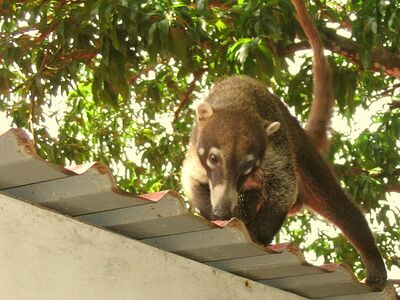
 
Coatis, genera Nasua and Nasuella, also known as Brazilian aardvarks, Mexican tejón, hog-nosed coons, pizotes, crackoons and snookum bears, are members of the raccoon family (Procyonidae). They are diurnal mammals native to South America, Central America, and south-western North America. The word "coatimundi" (pronounced /koʊˌɑːtɨˈmʌndi/) is a commonly used misnomer applied to solitary adult males of N. nasua. The term is reported to be derived from the Tupi language (Paraguay).
Physical characteristics[]
Adult coatis measure 33 to 69 cm (13 to 27 in) from head to the base of the tail, which can be as long as their bodies. Coatis are about 30 cm (12 in) tall at the shoulder, and weigh between 3 and 8 kg (6.6 and 18 lb), about the size of a large housecat. Males can become almost twice as large as females and have large, sharp canine teeth.
All coatis share a slender head with an elongated, flexible, slightly upward-turned nose, small ears, dark feet, and a long, non-prehensile tail used for balance and signaling.
Ring-tailed coatis have either a light brown or black coat, with a lighter under-part and a white-ringed tail in most cases. Coatis have a long brown tail with rings on it which are anywhere from starkly defined like a raccoon's to very faint. Like raccoons and unlike Ring-tailed Cats and Cacomistles, the rings go completely around the tail. Coatis often hold the tail erect, and it used as such to keep troops of coatis together in tall vegetation. The tip of the tail can be moved a bit on its own, as is the case with cats, but it is not prehensile as is that of the kinkajou, another procyonid.
Coatis have bear- and raccoon-like paws, and coatis, raccoons, and bears walk plantigrade (on the soles of the feet, as do people). Coatis have non-retractable claws. Coatis also have in common with raccoons and other procyonids (and others in the order Carnivora and rare cases amongst other mammals) double-jointed and ankles rotatable beyond 180° and therefore the ability to descend trees head-first. Other animals living in forests have acquired some or all of these properties through convergent evolution, including members of the mongoose, civet, ferret-skunk, cat, and bear families. Some of these animals walk on the toes of the front paws and soles of the back paws.
The coati snout is long and somewhat pig-like (see Suidae) and extremely flexible and can be rotated up to 60° in any direction, the former being part of the reason for its nickname the hog-nosed raccoon. The nose is utilized to push objects and rub parts of their body.
The facial markings include white markings around the eyes and on the ears and snout.
Coatis have strong limbs to climb and dig, and have a reputation for intelligence, like their fellow procyonid the raccoon.
They prefer to sleep or rest in elevated places and niches, like the rainforest canopy, in crudely-built sleeping nests.